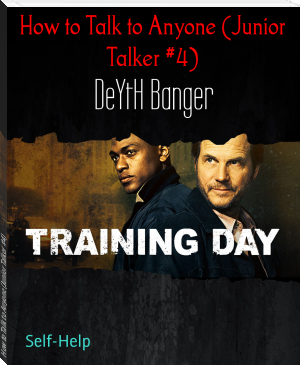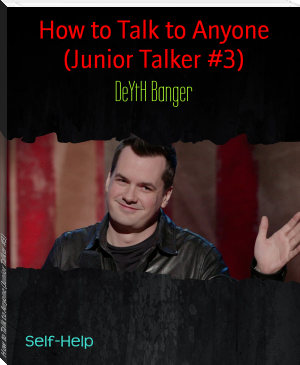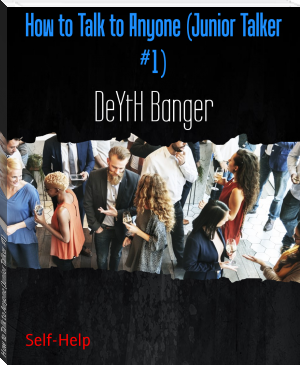How to Talk to Anyone (Junior Talker #4) by DeYtH Banger (novels in english TXT) 📕

- Author: DeYtH Banger
Book online «How to Talk to Anyone (Junior Talker #4) by DeYtH Banger (novels in english TXT) 📕». Author DeYtH Banger
How to Make Everything Funny – Robin Williams Charisma on Command
How to Make Everything Funny – Robin Williams Charisma on Command
“Playing a Character” is a technique that is fantastic for comedy. It’s telling a joke or story and imitating someone that you are not. This can be a person who is in the room or it can be a type of person that maybe you have only met before.
The point of this is that it’s not just about what you say but it’s about how you say it. It’s putting on the accent, it’s speaking with the same dialect that someone speaks with, it’s moving like that person, it’s walking around saying the types of things that they would say, and it’s also imitating the gestures that they would make.
The more that you put this together and you commit to actually playing a character, the easier it is to make any sort of joke very funny.
Note: Just stop giving a fuck... stop caring... all what they say like:
You suck You are disgusting You are awful You are badass biatch You are whinny biatch
or even
Tosser – Supreme Asshole or jerk. Wanker – Idiot Slag – Whore, the worst kind Cheese Eating Surrender Monkeys – The French Lost the plot – Gone crazy or completely stupid. Daft Cow – Dumb, large woman Arsehole – Asshole Barmy – Stupid or crazy. Chav – White Trash / Low Class Dodgy – Shady character Git – Moron, Idiot Gormless – Complete lack of common sense Manky – Disgusting Minger – Very unattractive woman Muppet – Dimwit (not the puppet variety) Naff – Tacky Nutter – Someone’s who’s clearly crazy Pikey – White trash – also used to slight Gypsies or Irish Travellers Pillock – Idiot Plonker – Idiot Prat – Idiot, asshole Scrubber – A nicer way to say slag Trollop – A lady of questionable morals Uphill Gardener – Another way of saying homosexual Twit – Idiot Knob Head – Dickhead Piss Off – Go Away Bell End – Dick Head (bell end also means penis) Lazy Sod – Useless idiot Skiver – Lazy sod Knob – Dick Wazzock – Someone so dumb they can only do manual labor (from Yorkshire) Ninny – Brilliant but inferior Berk – Idiot Airy-fairy – Not strong, weak. Ankle-biters – Children Arse-licker – A sycophant Arsemonger – A person that generate contempt. Chuffer – An annoying perfusion Daft as a bush – Silly, Crazy Dead from the neck up – Stupid. Gannet – Greedy person. Gone to the dogs – rotten, deteriorated Ligger – freeloader Like a dog with two dicks – Man whore Mad as a bag of ferrets – Crazy Maggot – A despicable person Mingebag – A bad person, an asshole who might be cheap. Not batting on a full wicket – Eccentric person a little crazy or odd. Plug-Ugly – Very Ugly person
- Ugly
- Fat
- Dumb
- Idiot
...
All this is not true... no proper argument can secure this whole point....
...
And even it's true... go and throw a laugh... don't get insulted!
P.S. - To get somewhere you need to be carefree... to give less fuck... bold and confident... and once in that path try to stick on it.
How To Be Persuasive (When You NEED People to Change) – Barack Obama Charisma Breakdown
How to Be Persuasive When You Need People to Change
This video shows you how to be persuasive when you need people to change.
The truth is there are situations in our lives, like our social lives where you don’t have to be persuasive. If you don’t get along with someone, guess what? You can filter the people in your life and keep the people that are positive and lift you up.
But, in certain situations (particularly the working world) you are going to have work with people who disagree with you. And you can’t just filter them out so you need to know how to be persuasive against obstinacy. This video will show you how.
In the wake of the tragedy at Umpqua Community College in Oregon, Barack Obama demonstrates a 5 step process on how to be persuasive in those situations where you absolutely must convince people to change their behavior. Great for being more persuasive in the workplace!
Step 1 : Introduce the problem
Step 2: Handle objections before people actually bring them up
Step 3: Show them how their values are in line with your new plan
Step 4: Outline how great things could be with your new plan
Step 5: Ask at the end
At the end of the day, you cannot make anyone do anything. Persuasion means getting them to want to do things on their own and take ownership over an idea that may have started in your head is cultivated in theirs.
TIP: Focus on Baseline
TIP: Try now to say everything which comes to your mind... and also use 3 Second rule - For approach (Which means when afte 3 seconds... you approach your "TARGET")
Body Language in Nonverbal Communication
Nonverbal communication is the message that is transferred between persons by our body language such as facial expressions, head movements, body posture and actions, clothing, mannerism, personality behaviour, etc.
You probably heard that 55% of the total impact of our personal communication is determined by our body language (nonverbal communication). Another 38% is determines by the tone of our voice. And only 7% is determined by the words we use (verbal communication).
Researchers have found that some specific acts in our body language have specific meanings.
For instance, head, facial movements and gestures give information about the type of emotion being expressed; body position and tension reveal the intensity of the feeling.
One body language I notice a lot in people is the facial grimace when they listen to someone labouring to express or explain something.
This is quite rude actually, it is as if they are saying, "Come on can't you tell it fluently", "Why are you having such a hard time to talk", rather than just patiently waiting and listening for the person to speak in the best way he/she can.
Another type of body language example is someone dozing off during a seminar presentation; this says something about the feelings of that participant toward the seminar, the speaker or the company -- either the presenter is boring, or the participant is totally disinterested and disrespectful.
In all of this body language analysis, caution is necessary. Too many people will read a book or study a course in body language and begin a post-study exaggerated scrutiny of others.
Just because a book says that "crossing the arms over the chest" is a sign of domineering or uncooperation, it does not mean that everyone taking that posture is expressing that message. Not at all.
How many times have you done it and you were not being uncooperative. Often, this posture is simply because one is tired of having his/her arms hang down the sides during someone's long, drawn out speech! It is a comfortable position. I do it often without any negative meaning whatsoever.
I have seen in meetings, some of the most positively responding people, listening intently to a presenter, being most cooperating and happy about what the presenter was saying or doing -- all with arms crossed over the chest!
Another common body language topic is about the speaker's eyes intermittently moving around the room while talking. This is construed to mean several things. I've even seen listeners look up to the ceiling because the speaker's eyes were focused there momentarily.
Some studies have gone to the extent of saying that the direction of the eyes even tells what information they are "fetching" where in the brain (i.e. eyes to the left, searching in the right brain, eyes to the right, searching in the left, etc.).
I've seen people looking toward one corner of a room while speaking simply because there happened to be a distraction there!
The right-brain/left-brain mechanism has a lot of truth to it, but sometimes "experts" can get too carried away. Nobody understands everything about the brain yet.
Most times, people are just "searching" for their thoughts. Actually if you observe carefully, you will notice that people disconnect eye contact intermittently while talking, but focus steadfastly while listening. Most of us do that.
Neither does disconnecting eye contact with the listener necessarily mean the individual is hiding something from his listener -- or lying as some "expert" will tell you. They may sometimes do that, but more often they don't. These conclusions are study results of behavioural extremes.
Rather than saying that the movement or disconnect of the eyes in a certain way while speaking to another represents deception, teachers should say, "... it could mean deceiving or lying, but it usually means the person is searching for words, may be shy or uncomfortable in the presence of authority or a stranger, or simply is not aware of a bad habit.
And there could be a whole list of other reasons. Shyness is often the cause of such behaviour. My sweet little seventy-five year old mother is so shy that she can't even look in the eyes of the cashier at the grocery store!
Someone may have never been taught how to communicate. Indeed, this habit is eliminated after a person has been made aware of it and has worked at correcting it -- in other words after conscientiously reconditioning him/herself.
Politicians or public relations people learn communication and body language as part of their experience or training. I watch this all the time and find it most amazing how some can stay the course of their eyes constant on the listener even while speaking. Some are born or raised to be able to do it -- it's part of their personality type.
But someone who does not work in a public environment, has not been taught about it, is not as skilled and may even never have heard of it! Make it a point to begin to observe this, and then begin to train yourself. It's not easy. Or you might find that you are doing quite well as you are. Then appreciate that fact and feel good about yourself.
3 V's of Communication
by Samira Gupta
As an Image Consultant and a life Coach, I like to say that the most essential elements of good communication are three - V's.
Visual Communication
Vocal Communication
Verbal Communication
Visual Communication:
Visual Communication is all about what you communicate through your body language, dressing, grooming, hygiene eye contact, hand gestures, tone and everything else that you are not speaking or saying. In other words, we communicate a lot without having to speak.
Knowing well about Visual Communication, not only helps you to maintain a relaxed, open stance like arms open, legs relaxed and a friendly tone, it also helps you read other people's mind through their visual communication.
Remember, at all times keep a smile on your face and keep a healthy eye contact through out your conversation. It will make the other person sure that you are focused on the conversation, however, be sure not staring at the person, which can make him or her uncomfortable.
Often, nonverbal signals do convey how a person is feels. For example, if the person is not looking you in the eye, he or she might be uncomfortable or hiding the truth.
For your upcoming important meeting, dress well, be well groomed - your hair should be made up well, beard trimmed (for men, clean shaven look is the best otherwise), clean and well trimmed nails, make sure you are smelling good, maintain a smile and a good eye contact. It will surely increase the chances of success of that meeting by creating a good and a powerful first impression.
Vocal Communication:
Vocal Communication is all about what we speak - the tone and how much. The right vocal means saying just enough - don't talk too much or too little. You must convey the message in as few words as possible. Say what you want as clearly and directly as possible, whether you're speaking to someone in person, on the phone, or via email. If you are not able to do that, your listener will either tune you out or will be unsure of exactly want you want to communicate.
Always be polite in all of your professional or workplace communication. If you do so, you will encourage your colleagues to engage in an honest communication with you.
At all times, be confident in your communication with others. Confidence shows your personal as well as your coworkers that you believe in what you're communicating and will follow through. A firm, yet friendly tone is





Comments (0)